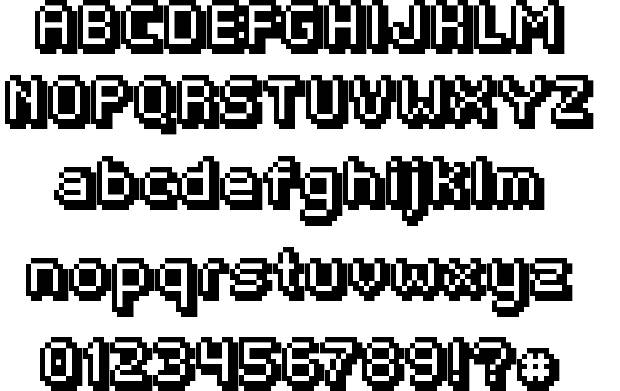
ClearType uses spatial anti-aliasing at the subpixel level to reduce visible artifacts on such displays when text is rendered, making the text appear "smoother" and less jagged. Computer displays where the positions of individual pixels are permanently fixed – such as most modern flat panel displays – can show saw-tooth edges when displaying small, high-contrast graphic elements, such as text. If you want to modify the image further such as rotating, bending or blurring, you can. You can then save the image, or use the EMBED button to get image links. You can use the following tool to generate text graphics based on your selection of colors, text effects and sizes using pixel fonts in seconds. Create Text Graphics with Pixel Fonts.

Pixel Text Fonts Portable Computing Field
Dick Brass, a Vice President at Microsoft from 1997 to 2004, complained that the company was slow in moving ClearType to market in the portable computing field. It was then analyzed by researchers in the company, and signal processing expert John Platt designed an improved version of the algorithm. ClearType was invented in the Microsoft e-Books team by Bert Keely and Greg Hitchcock. In theory, the method (called "RGB Decimation" internally) can enhance the anti-aliasing of any digital image. For example, ClearType enhancement renders text on the screen in Microsoft Word, but text placed in a bitmapped image in a program such as Adobe Photoshop is not. ClearType does not alter other graphic display elements (including text already in bitmaps).
Pixel Text Fonts Full Pixel Must
In 4K displays, ClearType gives wide colored shadows to the letters of old applications. This effectively triples the horizontal resolution of the image at normal viewing distances the drawback is that the line thus drawn will show color fringes (at some points it might look green, at other points it might look red or blue).In Windows 10, if ClearType is turned off, it still remains in some GUI elements. If the line passes through the leftmost portion of the pixel, only the red subpixel is lit if it passes through the rightmost portion of the pixel, only the blue subpixel is lit. For example, if a diagonal line with a width smaller than a full pixel must be rendered, then this can be done by lighting only the subpixels that the line actually touches. If each pixel on the display actually contains three rectangular subpixels of red, green, and blue, in that fixed order, then things on the screen that are smaller than one full pixel in size can be rendered by lighting only one or two of the subpixels.
ClearType also yielded higher readability judgments and lower ratings of mental fatigue." A 2002 study on 24 users conducted by the same researchers from Clemson University also found that "Participants were significantly more accurate at identifying words with ClearType™ than without ClearType™."According to a 2006 study, at the University of Texas at Austin by Dillon et al., ClearType "may not be universally beneficial". This and the previous example with the orange circle demonstrate the blurring introduced.A 2001 study, conducted by researchers from Clemson University and The University of Pennsylvania on "18 users who spent 60 minutes reading fiction from each of three different displays" found that "When reading from an LCD display, users preferred text rendered with ClearType™. It looks and reads just fine to me." One illustration of the potential problem is the following image:In the above block of text, the same portion of text is shown in the upper half without and in the lower half with ClearType rendering (as opposed to Standard and ClearType in the previous image). Conversely, at 144 dpi, I don’t see a problem with Method C. It reads “blurrily” to me.
Gugerty’s group also showed, in a sentence comprehension study, that ClearType boosted reading speed by 5 percent and comprehension by 2 percent. In a 2004 study, for instance, Lee Gugerty, a psychology professor at Clemson University, in South Carolina, measured a 17 percent improvement in word recognition accuracy with ClearType. Another 2007 empirical study, found that "while ClearType rendering does not improve text legibility, reading speed or comfort compared to perceptually-tuned grayscale rendering, subjects prefer text with moderate ClearType rendering to text with grayscale or higher-level ClearType contrast." A 2007 survey, of the literature by Microsoft researcher Kevin Larson presented a different picture: "Peer-reviewed studies have consistently found that using ClearType boosts reading performance compared with other text-rendering systems. Whether ClearType, or other rendering, should be used is very subjective and it must be the choice of the individual, with the report recommending "to allow users to disable if they find it produces effects other than improved performance". Additionally, over one third of the study participants experienced some disadvantage when using ClearType.
Some flat panels have unusual pixel arrangements, with the colors in a different order, or with the subpixels positioned differently (in three horizontal bands, or in other ways). ClearType assumes this arrangement of pixels when rendering text.ClearType does not work properly with flat-panel displays that are operated at resolutions other than their “native” resolutions, since only the native resolution corresponds exactly to the actual positions of pixels on the screen of the display.If a display does not have the type of fixed pixels that ClearType expects, text rendered with ClearType enabled actually looks worse than type rendered without it. Almost all flat panels have a perfectly rectangular array of square pixels, each of which contains three rectangular subpixels in the three primary colors, with the normal ordering being red, green, and blue, arranged in vertical bands. This is the case for flat-panel displays, on which the positions of the pixels are permanently fixed by the design of the screen itself. More precisely, the positions of the pixels and subpixels on the screen must be exactly known to the computer to which it is connected.


 0 kommentar(er)
0 kommentar(er)
